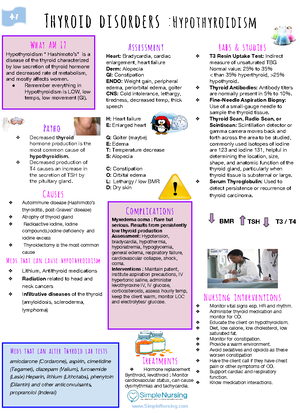- Information
- AI Chat
Was this document helpful?
30 - dsfdsf
Course: Pathophysiology (NSG 211)
33 Documents
Students shared 33 documents in this course
University: Marian University
Was this document helpful?

Chapter 30: Pituitary Drugs
Lilley: Pharmacology and the Nursing Process, 10th Edition
MULTIPLE CHOICE
1. The nurse notes in a patient’s medication history that the patient has been taking
desmopressin. Based on this finding, the nurse interprets that the patient has which disorder?
a.
Diabetes mellitus
b.
Diabetes insipidus
c.
Adrenocortical insufficiency
d.
Carcinoid tumor
ANS: B
Desmopressin is used to prevent or control polydipsia (excessive thirst), polyuria, and
dehydration in patients with diabetes insipidus. The symptoms are caused by a deficiency of
endogenous antidiuretic hormone. The other options are incorrect.
DIF: Cognitive Level: Understanding (Comprehension)
TOP: Nursing Process: Assessment
MSC: NCLEX: Physiological Integrity: Pharmacological and Parenteral Therapies
2. A 16-year-old boy who is taking somatropin comes into the office because he had an asthma
attack during a race at school. Because of this new development, the nurse expects which
intervention to occur next?
a.
He will need to stop participating in school physical education classes.
b.
The somatropin must be discontinued immediately.
c.
The somatropin dosage may be adjusted.
d.
His growth will be documented and monitored for changes.
ANS: C
Somatropin is to be used with caution in acute or chronic illnesses, such as migraine
headaches, epilepsy, and asthma. It will not have to be immediately discontinued but will
require close monitoring. The patient’s growth will be measured and documented throughout
therapy with somatropin.
DIF: Cognitive Level: Applying (Application)
TOP: Nursing Process: Implementation
MSC: NCLEX: Physiological Integrity: Pharmacological and Parenteral Therapies
3. When a patient is receiving vasopressin, the nurse will monitor for which therapeutic
response?
a.
Improved appetite
b.
Increased serum albumin levels
c.
Increased serum potassium levels
d.
Decreased urinary output
ANS: D
Decreased severe thirst and decreased urinary output are the therapeutic responses expected
with vasopressin. The other options are incorrect.
DIF: Cognitive Level: Understanding (Comprehension) TOP: Nursing Process: Evaluation

















